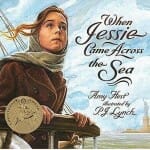 Usually I write about multicultural picture books that have been published within the last few years. It is not surprising that I almost passed on the book, When Jessie Came Across the Sea, by award winning author, Amy Hest, and illustrated by, P. J. Lynch. Candlewick Press published the book in 1997.
Usually I write about multicultural picture books that have been published within the last few years. It is not surprising that I almost passed on the book, When Jessie Came Across the Sea, by award winning author, Amy Hest, and illustrated by, P. J. Lynch. Candlewick Press published the book in 1997.
The impressive list of awards for both the content and the illustrations made me curious. Why did so many groups honor this book? Can an excellent book endure the test of time?
As I took a picture walk through the book, I immediately felt the thick textured pages. I wondered if P.J. Lynch’s award winning, muted, painted pictures would be appreciated by a modern audience that is usually stimulated by bold and striking colors. The detailed pictures effectively supplement the story by taking the reader back to an earlier place and time when Eastern European Jewish immigrants traveled by ship to America in order to improve their living conditions.
Jessie, an orphan, lived with her grandmother in a small 19th century Eastern European village. Jessie is selected by her rabbi to take a journey to America. Leaving behind the world she knew and her beloved grandmother, Jessie agrees to take passage on a ship and start a new life with one of the rabbi’s relatives in America.
The dialogues between Jessie and her acquaintances help to propel the story and reveal Jessie’s character. Short correspondences between Jessie and her aging grandmother highlight the special relationship between the grandmother and her granddaughter and the literacy levels of both women. A budding romance between a fellow ship passenger and Jessie adds an additional layer to the plot. It is not surprising that the book ends on a happy note with the prospect of marriage between the two and the grandmother finding her way to America.
The migration of Eastern European Jews is a vital aspect of Jewish history. More than 2.5 million Jews made the journey between 1881-1914. This story does not mention the socio-political reasons for the mass migration but instead concentrates on the journey and the adjustments to a new country.
Many modern day immigrants will be able to relate to Jessie’s feelings. Additionally, students can use this story as a stepping stone for future research. For some students, the facts associated with their family’s immigration story may be easy to locate while for others the researching may be more challenging or be entangled in secrecy. Illegal immigrants may be uncomfortable divulging the facts surrounding their immigration experiences.
Awards
- Parents’ Choice Award- Gold
- Sydney Taylor Honor Book Award
- The Christopher Award
- American Booksellers Book of the Year Award- honor
- Notable Children’s Trade Book in the Field of Social Studies
- Association of Booksellers for Children Choice Award
- International Reading Association Notable Book
- Kate Greenaway Medal (illustrations)
Discussion Topics
- Life in Eastern European villages
- 19th century immigration to America
- Compare/contrast modern immigration with earlier waves of immigration
- Learning to adapt to a new culture and language
- Orphans
- Relationship between grandparents and grandchildren
- Children traveling alone-(independence and bravery)
- Learning new skills
- Being separated from loved ones
- Researching and reporting about family’s immigration stories
- Cultural diversity- acknowledging students’ roots
Question
- How do you handle students who do not want to share their family’s past?
Leave a Reply
You must be logged in to post a comment.